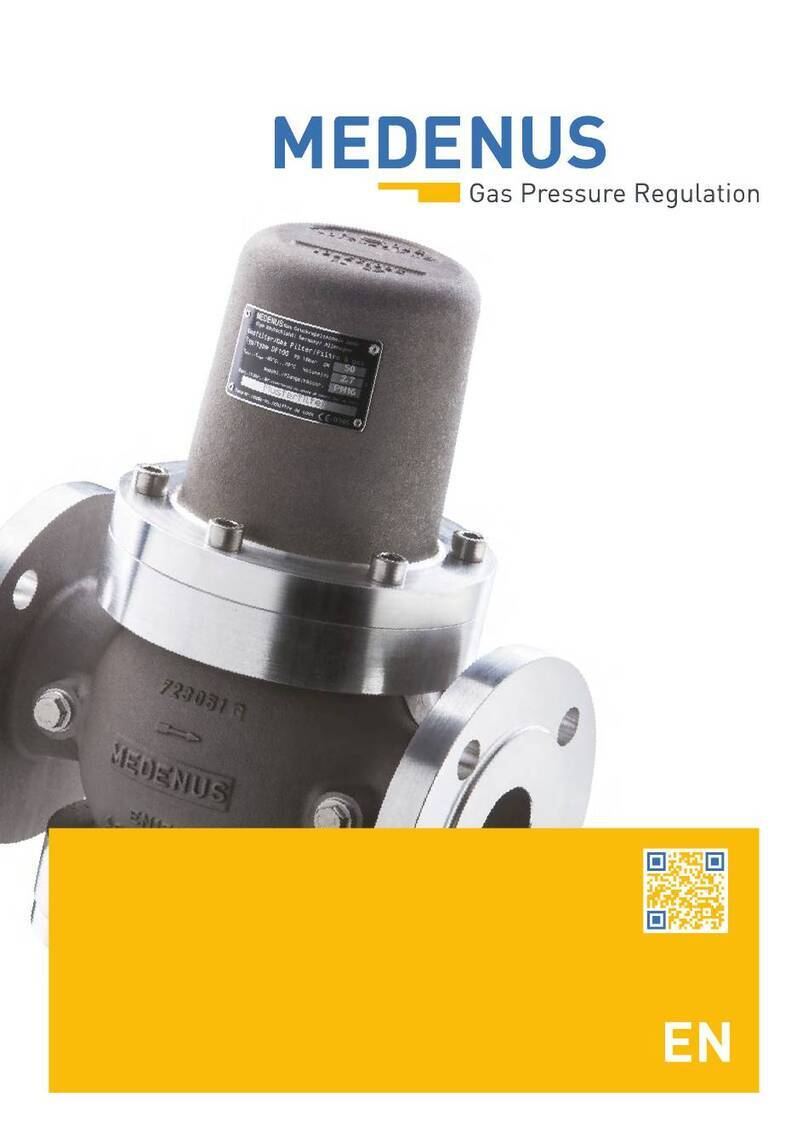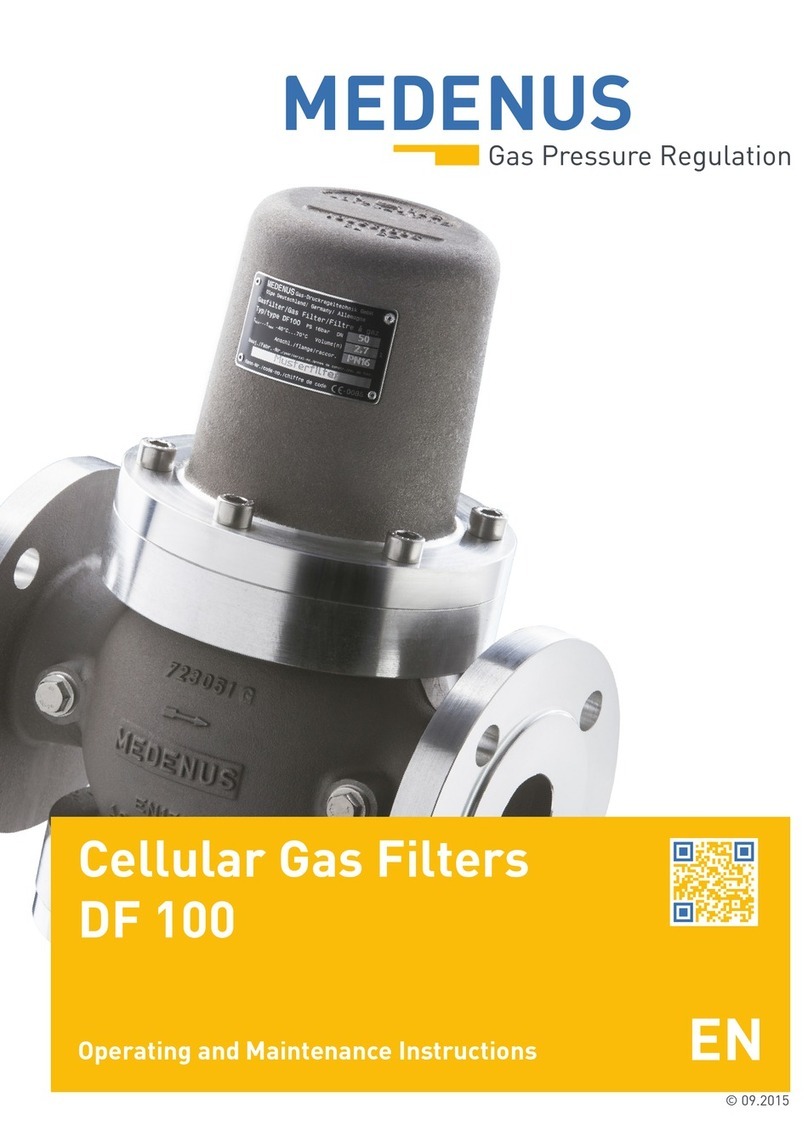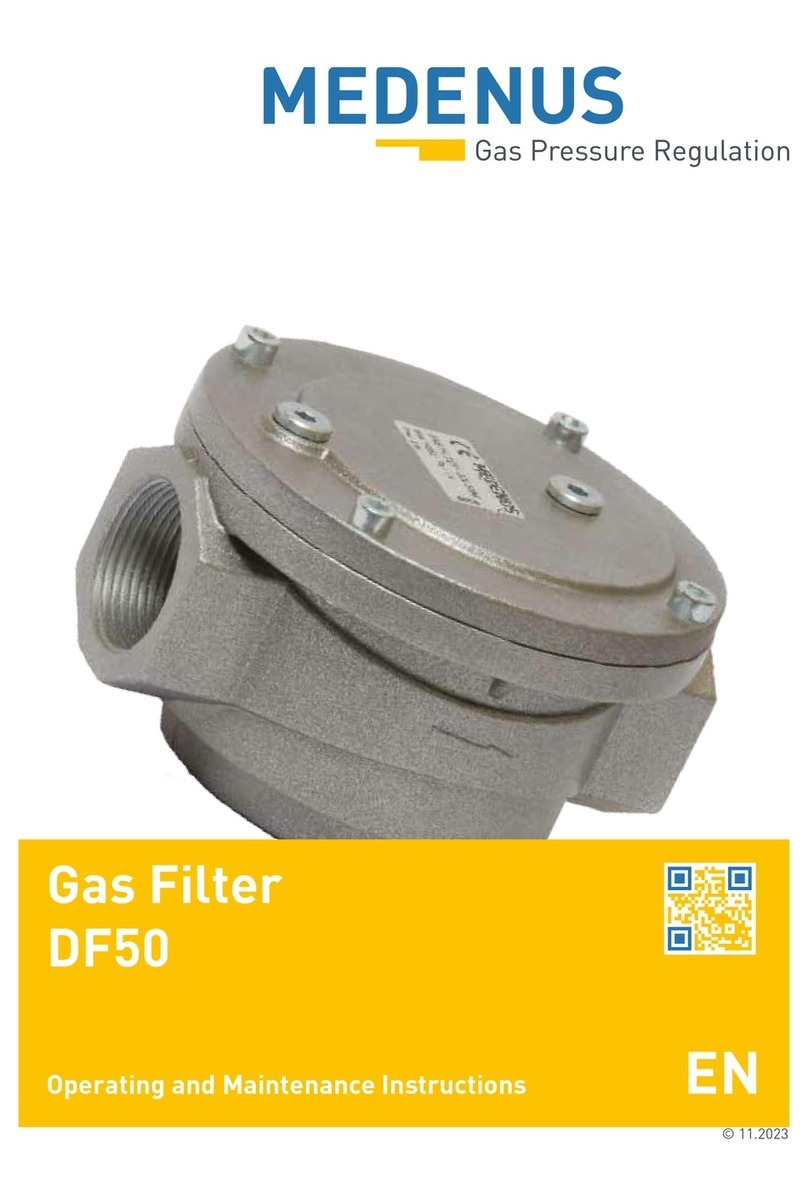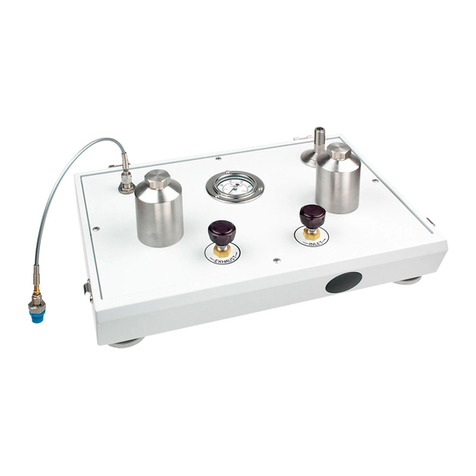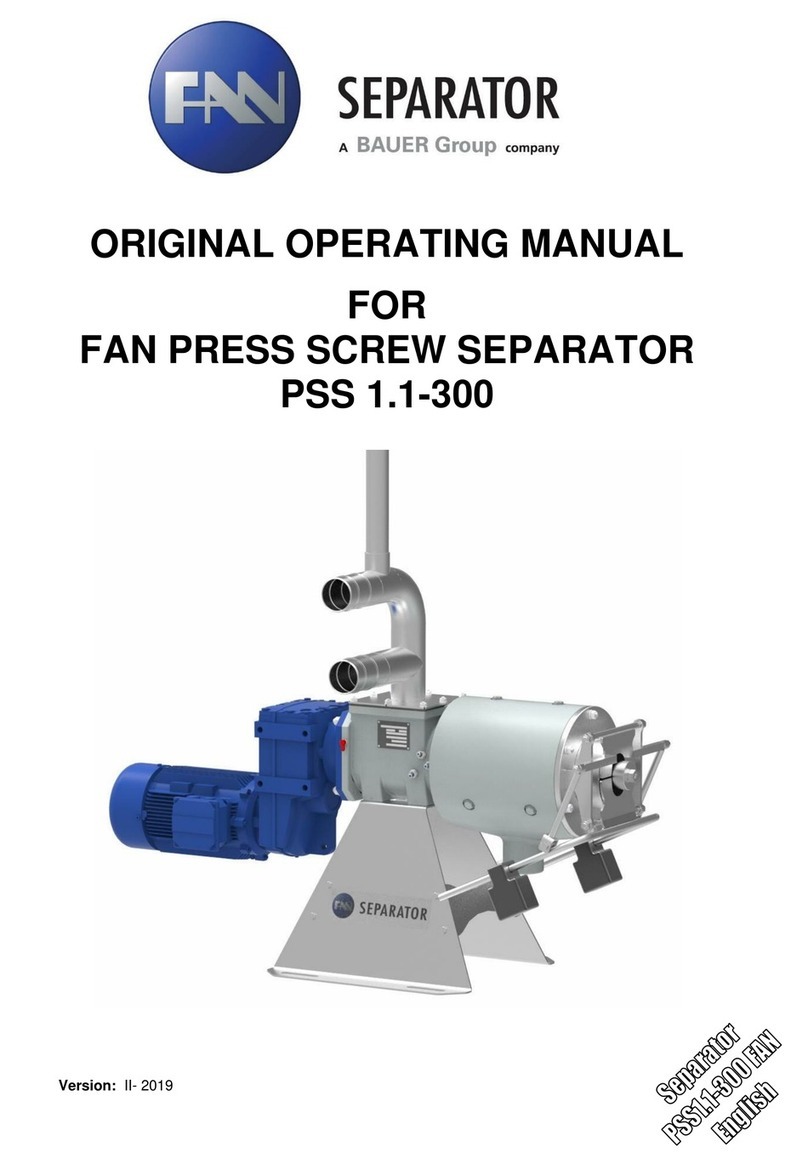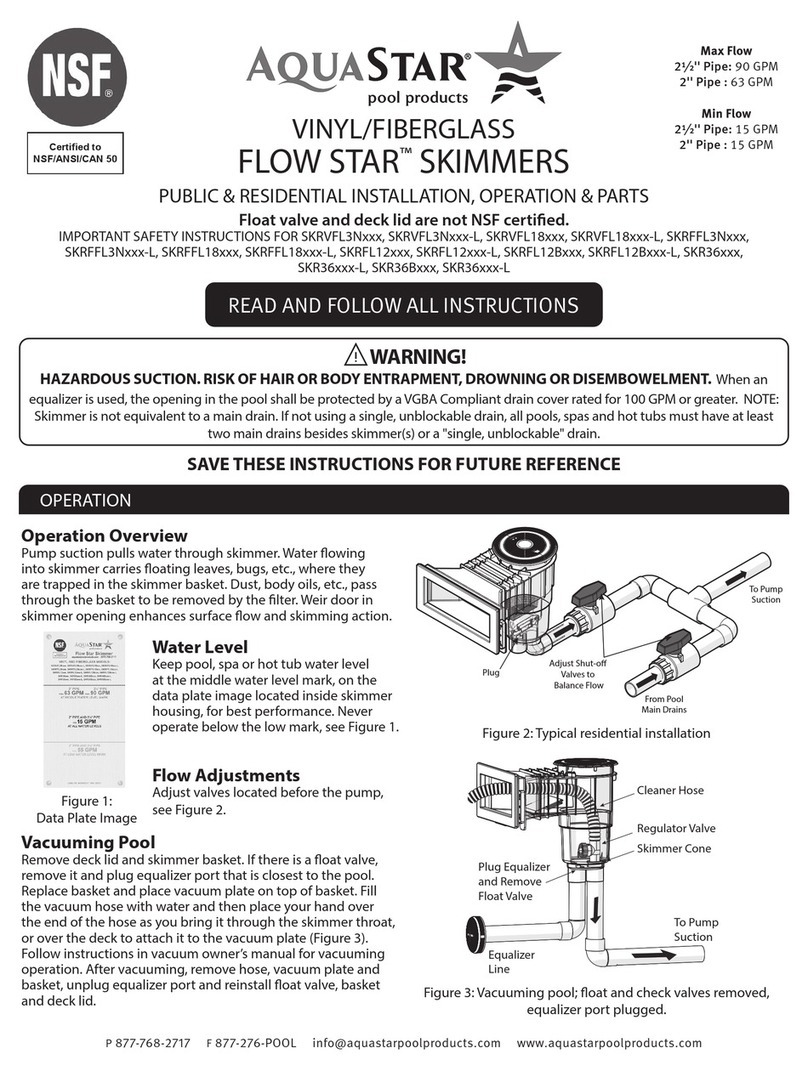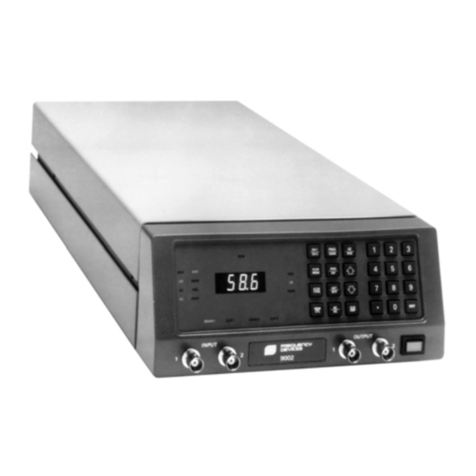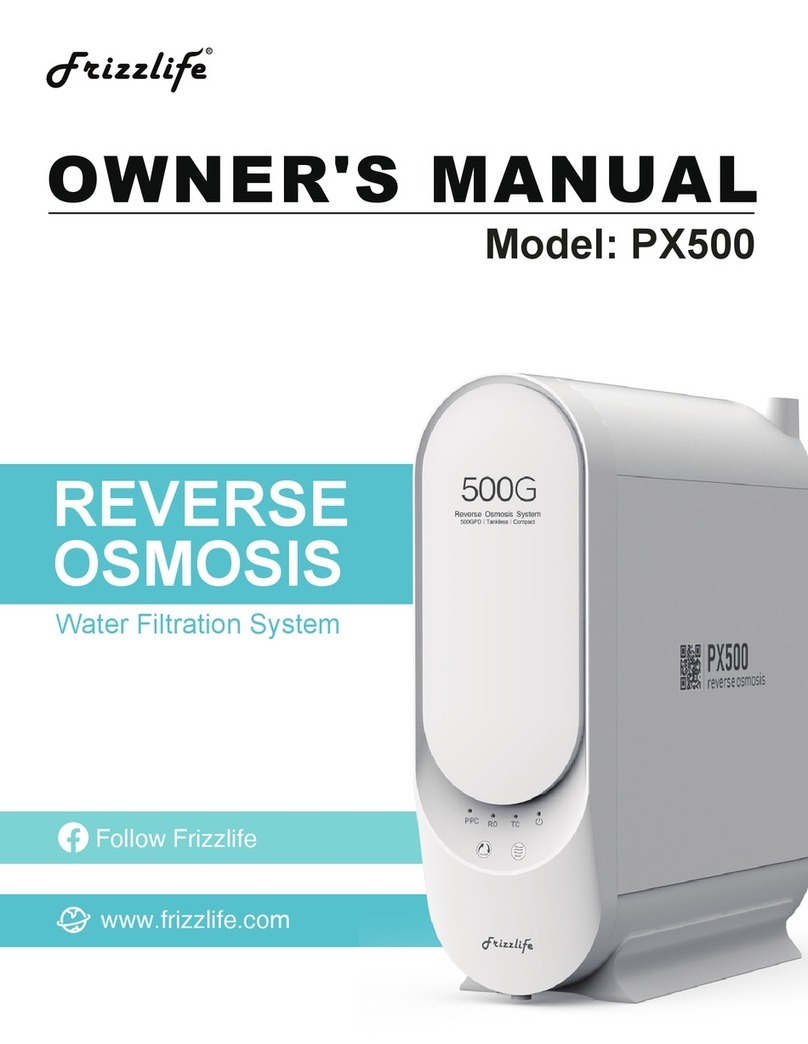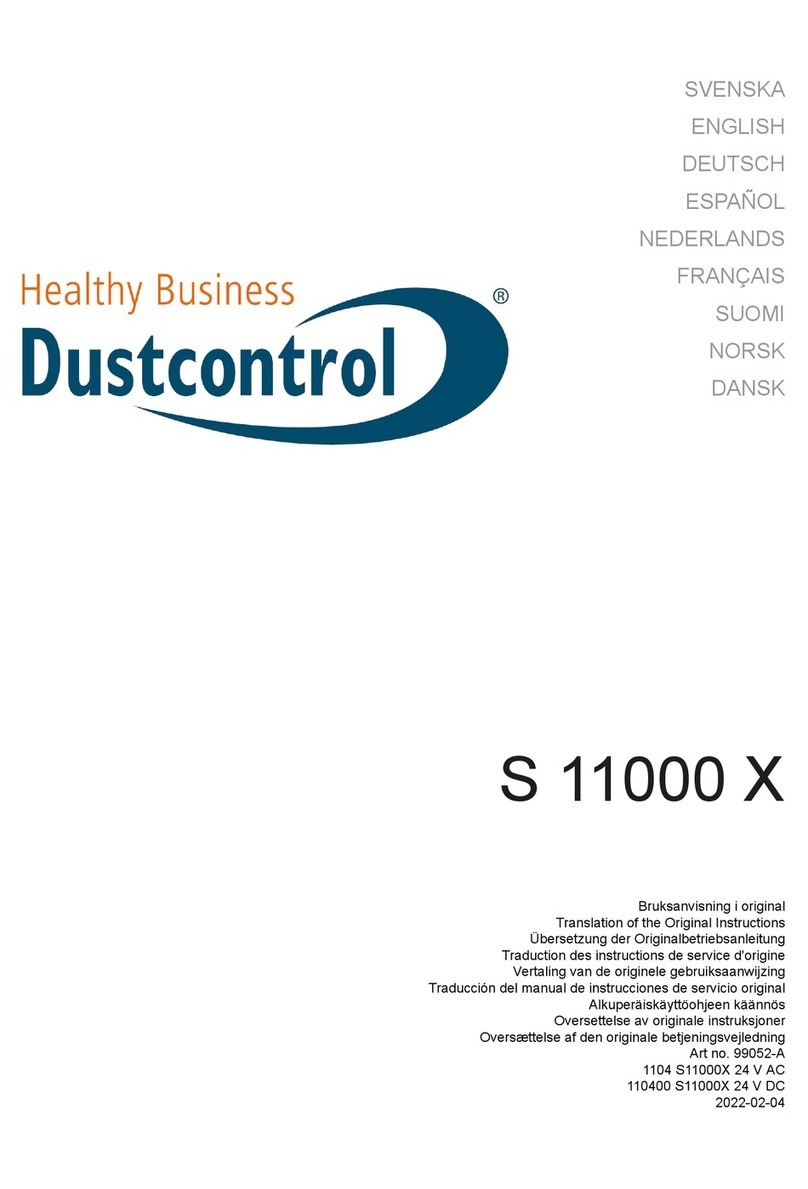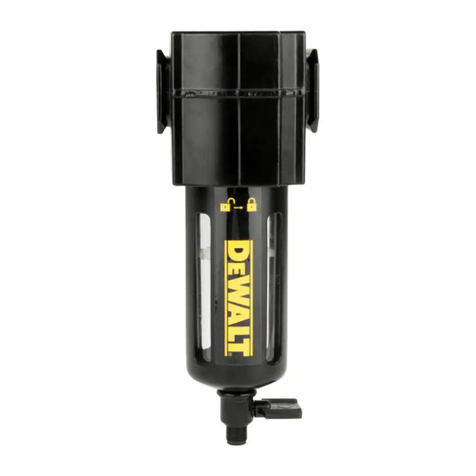MEDENUS DF 100 Manual

© 05.2022
Cellular Gas Filter
DF 100
Operating and Maintenance Instructions

Subject to technical modifications! Reprint prohibited!

Design of the cellular gas filter DF 100
shown DN 50
Hood
Filter cartridge
Housing
Cover

Table of Contents
1 General Information 6
1.1 Warranty and Liability 6
1.2 Symbols, Notes 7
1.3 Terms, Abbreviations 7
2 Application, Characteristics 8
2.1 Application 8
2.2 Characteristics 8
2.3 Types of Models (Options) 8
3 Avoidance of Foreseeable Misuse 8
4 Safety Instructions 9
4.1 Hazards of Handling the Device 9
4.2 Personnel Requirements 9
4.3 Country-Specific Requirements 9
4.4 Handover of the Operating and Maintenance Instructions 9
4.5 Safety in Operation 10
4.6 What To Do in Case of Danger 10
5 Responsibility of the Operator 10
6 Transport, Storage and Packaging 11
6.1 Transport 11
6.2 Storage 11
6.3 Packaging 11
7 Mounting and Commissioning 12
7.1 Safety Instructions and Preparation 12
7.2 Mounting 12
7.3 Leakage Test (Test for External Leakage) 13
7.4 Initial Commissioning / Recommissioning 13
7.5 Decommissioning 13
8 Maintenance 14
8.1 Maintenance Plan 14
8.2 Maintenance Procedure 14
8.3 Table of Screw Tightening Torques MA15
8.4 Lubricants Table 16
Oxygen model 16
For oxygen models, a suitable grease which is approved for the use 16
with oxygen must be used. 16
9 Troubleshooting 16
10 Replacement and Disposal 16
11 Spare Parts 17
11.1 Spare Parts Drawing DF 100 17
11.2 Parts for Maintenance Work 17
O-rings 17
O-rings for low temperatures (-40°C) 17
Filter cartridge 17
Notes 18

12 Accessories / Options 19
12.1 Differential pressure gauge 19
Declaration of Conformity 26
Notes 27

6
© 05.2022
1 General Information
The personnel entrusted with installation, operation or maintenance of the cellular gas filter must
have completely read and understood beforehand the following documents:
• Product information of the cellular gas filter DF 100
The product information contains technical data, dimensions and a description of the design and the mode of
operation.
• Operating and maintenance instructions of the cellular gas filter DF 100
This document allows safe and efficient handling of the device and contains information on assembly,
commissioning, maintenance, troubleshooting, and repair according to regulations.
It is an integral part of the scope of delivery of the device, must be kept in close proximity of the device and
must be readily accessible to personnel at any time.
The basic prerequisite for safe working is compliance with all safety instructions and instructions for action
given in this manual. Accordingly, the information and instructions must be observed when working on the
device or on the gas line. In addition, the local occupational safety regulations and general safety regulations
for the application range of the device shall apply.
The figures in these instructions are provided for basic understanding and may differ from the actual design.
The contents of these instructions are protected by copyright. They may be used as part of operating the
device. Any other use and/or reproduction is not permitted without prior authorization by MEDENUS Gas-
Druckregeltechnik GmbH.
1.1 Warranty and Liability
Claims under warranty or liability for personal injury and material damage are generally void,
if one or several of the following conditions are not observed:
• Work on the device during the warranty period may only be performed in consultation with the manufacturer
• Designated use of the device in accordance with the established conditions of use
• Proper installation, commissioning, operation and maintenance of the device
• Operation of the device with properly installed and functioning safety devices only
• Operating and maintenance instructions of the device or of the system
• Compliance with the maintenance instructions
• Properly performed repairs
• Supply lines without defects
• The use of original MEDENUS©spare parts and lubricants listed in these instructions or
• Force majeure
It is generally prohibited
• To perform constructive modifications on the device
• To keep using the device despite the detection of a defect

7© 05.2022
1.2 Symbols, Notes
The instructions contain safety instructions marked with symbols to indicate possible consequences in case of non-
observance:
1.3 Terms, Abbreviations
Terms and abbreviations are explained below:
DN Nominal width
MTScrew tightening torque
MOP Maximum operating pressure in a system
DANGER
Note
ATTENTION
This combination of symbol and signal word indicates a potentially hazardous
situation which, if not avoided, may result in minor or moderate injury, damage
to the device, the breakdown of the system, and material or environmental
damage.
This combination of symbol and signal word indicates an imminent hazardous
situation which, if not avoided, will result in death or serious injury.
This signal word highlights useful tips, recommendations, and information for
efficient and trouble-free operation.

8
© 05.2022
2 Application, Characteristics
2.1 Application
Type DF 100 cellular gas filters are intended to separate gas impurities such as dust, rust, and other solids in gas-
carrying lines at a defined point. They are mainly used in gas systems and in front of such devices whose function is
impaired by contamination.
Can be used as an equipment component on gas consumption facilities as defined in Regulation (EU) 2016/426.
These filters can be used for gases according to DVGW work sheet G 260/G 262 and for neutral non-aggressive gases.
(other gases on request)
2.2 Characteristics
• Open-airmodelasstandard
• Easilyreplaceablefiltercartridgewithhydrophobicfiltermedium
• Highseparationefficiencythanktooptimizedflowguidance
2.3 Types of Models (Options)
• Oxygenmodel
• withdifferentialpressuregauge
3 Avoidance of Foreseeable Misuse
• TheDF100cellulargasfiltersmustnotbeusedforfilteringliquids.
• TheDF100cellulargasfiltersmustnotbeusedintemperaturerangesbelow-40°Corabove70°C
• TheDF100cellulargasfiltersmustnotbeusedforpressurerangeshigherthanthepressure“PS“indicated
on the nameplate.
• TheDF100cellulargasfiltersmayonlybeusedforthegasesspecifiedunderitem2.1Applicationinthese
operating instructions.
Other gases, such as oxygen or hydrogen, must be explicitly stated on the nameplate.
Please consult the manufacturer before use.
• TheDF100cellulargasfiltersmustnotbeusedinhigh-temperatureareas(HTB)withoutanupstreamHTB
fuse.

9© 05.2022
4 Safety Instructions
National accident prevention regulations and the system operator's safety regulations are not superseded by these
operating and maintenance instructions and must be taken into consideration with priority (in Germany, see, among
others, DVGW work sheets G 600, G 459/II, G 491 and G 495).
When performing work on the device, the current general and
specific safety regulations must be observed.
The application limits of the device with respect to the medium, operating pressure and operating temperature can be
found on the nameplate affixed to the device or on the acceptance test certificate.
Using the device under different operating conditions must be agreed upon in consultation with
MEDENUS Gas-Druckregeltechnik GmbH.
The mechanical components of the device do not have any potential ignition sources of their own nor any hot surfaces
and are thus not covered by the scope of 2014/34/EU (ATEX). The electronic accessories used comply with the ATEX
requirements.
4.1 Hazards of Handling the Device
MEDENUS©devices conform with current standards and directives, the recognized technical rules,
and the recognized safety rules.
However, improper use can result in hazards to the user or to third parties. This can also result in damage to the device
or to the system.
This is why the device may only be used:
• in accordance with its designated use
• in perfect condition
• while observing the notes given in these operating and maintenance instructions, and inspection and
maintenance regulations, which apply to the functioning and safety of the overall system.
Malfunctions or faults must be eliminated immediately.
4.2 Personnel Requirements
The device may only be mounted by qualified personnel.
Only authorized personnel with the required qualification is allowed to perform settings or repairs on the device.
4.3 Country-Specific Requirements
The rules and regulations applicable at the place of use must be observed and complied with. They apply to:
• gas lines, installation of the gas system
• gas supply
• work on the gas system
• accident prevention
4.4 Handover of the Operating and Maintenance Instructions
The supplier of the system shall hand over these operating and maintenance instructions to the operator of the system
no later than during commissioning and training
of the operating personnel with the reminder to carefully store these instructions.

10
© 05.2022
4.5 Safety in Operation
The device may only be used when all protective devices on the device or in the system are fully functional.
At least once a year, the device must be inspected for externally visible damage and for proper functioning
by a representative of the manufacturer or by a qualified person.
A more frequent inspection may become necessary, depending on the system conditions.
4.6 What To Do in Case of Danger
Information on what is to be done in case of danger and in case of accidents can be found in the respective operator's or
specialist companies' work instructions.
5 Responsibility of the Operator
Operator An operator is a person who operates the device himself/herself for commercial or economic purposes
or leaves it to a third party for use/application and is legally responsible for the safety of the user, the
personnel or third parties during operation.
The device is used in the commercial sector. The operator of the device is therefore subject to the legal
obligations for occupational safety. In addition to the safety instructions contained in these instructions,
the established maintenance intervals must be observed, taking into account the respective national
standard (alarm and hazard prevention plan).
In particular, the following applies:
• The operator is obliged to perform work on MEDENUS©devices during the warranty period only
after consultation with the manufacturer. Otherwise the claims under warranty will become
void.
• The operator must obtain information on the current occupational safety regulations and
determine additional hazards resulting from the special work conditions at the place of use of
the device in a risk assessment. The owner must implement the results in the form of operating
instructions for the device.
• During the entire time of use of the device, the operator must check whether the operating
instructions issued by him/her conform to the current state of the regulations and, if necessary,
adapt them.
• The operator must clearly regulate and define the responsibilities for installation, operation,
troubleshooting, maintenance and cleaning.
• The operator must ensure that all persons handling the device have read and understood these
instructions. In addition, the owner must train the personnel at regular intervals and inform
them about the hazards.
• The operator must make available to the personnel the required protective equipment and
oblige them to wear the required protective equipment.
• Moreover, the operator is responsible for the device always being in technically perfect condition.
Therefore, the following applies:
• The operator must make sure that the maintenance intervals described in these instructions
are observed.
• The operator must have all safety devices checked regularly for functionality and completeness.
Operator
duties

11 © 05.2022
6 Transport, Storage and Packaging
6.1 Transport
The device is delivered with flange protection caps. They must be removed prior to installation.
Make sure that the device is transported horizontally using suitable lifting gear. The device must be
handled carefully and secured against impacts and knocks.
In case of transport damage, we will require the following information from the nameplate affixed to
the device:
• Device type
• Device model
• Year of construction/fabrication number
Note
6.2 Storage
Equipment and spare parts must be stored under the following conditions:
• Do not store outdoors.
• Store in a dry and dust-free location.
• Store on a flat surface.
• Do not expose to aggressive media.
• Do not expose to ozone or ionizing radiation.
• Do not store adjacent to direct heat sources.
• Avoid mechanical vibrations.
• Storagetemperature:0to25°C.
• Relative air humidity: < 55 %.
Spare parts:
• Components susceptible to corrosion must be provided with a suitable preservative.
• Do not store O-rings and seals for more than 5 years even if stored properly.
• Spare parts must be stored in their original packaging until use.
Storage period for devices:
• Storage of the device for up to one year:
Store the cellular gas filter in its original packaging and its original condition as delivered. All protective caps
of the device must remain mounted.
• Storage of the device for more than 1 year (e.g. as a spare device):
Store the device in its original packaging and its original condition as delivered and check it for damage once
a year. Check the housing surface for dirt, damage and corrosion. If necessary, clean all external parts. After
5 years, all O-rings and seals must be replaced.
6.3 Packaging
• The individual packaged items have been packaged in view of the transport conditions to be expected.
• The symbols on the packaging must be observed during transport and storage.
• Only environmentally friendly materials have been used for packaging.
• The packaging is designed for protecting the individual components from transport damage, corrosion and
other damage until mounting. This is why the packaging must not be destroyed and only removed just prior to
mounting.

12
© 05.2022
P1
P2
min. 5x DN
Inlet
Outlet
Range for
measuring points*
(approx. 3x DN P2)
Note
Note
7.2 Mounting
• Remove the packaging, flange protection caps and shipping braces.
• Check the device for wear and damage.
• Make sure that the device is installed free of stress. Make sure to observe the direction of flow
i.e., the arrow on the housing must point in the direction of flow.
Gas pressure regulators Flange tightening torques
Screw size Screw tightening
torque MA
Screw size Screw tightening
torque MA
M6 8Nm M12 60Nm
M8 18Nm M16 120Nm
M10 36Nm M20 190Nm
M12 62Nm
Tightening torques MA*)
*) For the assembly of the
flange connections, the maxi-
mum torques specified by the
flange and gasket manufac-
turers must be observed. The
values indicated here should
be considered as approximate
values.
7 Mounting and Commissioning
7.1 Safety Instructions and Preparation
Prior to starting work on pressurized components:
• Close all connections to the gas line.
• Depressurize all pressurized components. Also discharge residual energies.
• Defective components charged with pressure in operation must be replaced immediately by
an appropriate expert.
Prior to starting work, ensure sufficient clearance for mounting.
Before installing the device, check whether the performance data (nameplate) and the scope of
delivery coincide with the order or the system data, i.e., make sure that the provided devices are
suitable for their intended purpose. In particular, the inlet pressure of the system must be lower than
the maximum allowable pressure of the device.
Direct contact of gas valves and fittings, i.e., the control system, with hardening masonry, concrete
walls or floors is not permitted. Provide suitable supports, working materials and protective
equipment.
Take into account the minimum clearances for maintenance as stated in the product information.
Beforeinstallingthedeviceinthepipeline,checkwhetherashut-offdevicethatinterruptsthegas
flow supply to the device has been mounted upstream and downstream of the device to be installed.
Prior to commissioning, make sure that all installation work has been carried out and completed
in accordance with the data and information given in these instructions and that no unauthorized
persons stay in the danger zone.
DANGER
Note
Note
DANGER

13 © 05.2022
X
Y
Z
7.3 Leakage Test (Test for External Leakage)
The devices are subjected to a strength and leakage test ex works at MEDENUS Gas-Druckregeltechnik GmbH.
The leakage test in the fully assembled system must be performed prior to commissioning and following maintenance
work.
For the external leakage test in the fully assembled system, the following applies
For Germany:
According to the DVGW work sheet G 491, the fully assembled system must be subjected to a leakage test with air or an
inert gas at the installation site, using 1.1 times the maximum operating pressure of the system (MOP).
An exception is the room between the actuator of the gas pressure regulator installed in the system and the first shut-
off valve on the outlet side. This room must be checked using a test pressure corresponding to the maximum possible
setpoint of the gas pressure regulator. In this test, all detachable connections must be checked using a foaming agent.
For other countries:
The relevant national and international standards shall apply.
Procedure
• Close the ball valve upstream of the valves and fittings.
• Close the downstream shut-off devices (ball valves, solenoid or pneumatic valve).
• Depressurize the system.
• Connect the testing device to measuring points upstream and downstream of the filter.
• Always increase the test pressure slowly and steadily.
While doing so, you must ensure:
Pressure in outlet chamber ≤pressure in inlet chamber
Pressure build-up always from the inlet side (inlet chamber)
Pressure reduction always from the outlet side (outlet chamber)
7.4 Initial Commissioning / Recommissioning
For commissioning, please refer to the relevant manufacturer's documentation of the gas pressure regulator installed
in the system and the work instructions of the system operator.
7.5 Decommissioning
For decommissioning, please refer to the relevant manufacturer's documentation of the gas pressure regulator installed
in the system and the work instructions of the system operator.
Note
Connection
Abmessung /
dimension (mm) Nennweite /nominal size (DN)
Anschluss
Differenzdruck /
Connection differential
pressure
25 50 80 100 150 200
DF100
X 102 225 317 404 817 954
RP1/4“Y 80 116 138 188 195 225
Z 160 250 280 350 380 420

14
© 05.2022
8 Maintenance
8.1 Maintenance Plan
The following sections describe the maintenance work required for optimal and
trouble-free operation of the device. If increased wear is detected during regular inspections, the required
maintenance intervals must be shortened in accordance with the actual wear.
For any questions on maintenance work and intervals, please contact the manufacturer.
The intervals for monitoring and maintenance work are strongly dependent on the
operating situation and the condition of the gas. This is why no fixed intervals
can be given. For Germany, it is recommended that the maintenance periods as specified in the DVGW work sheet G 495
are observed initially.
For each system, this must be followed by determining the maintenance interval independently on a medium-term basis.
During maintenance work, the components must be cleaned and subjected to a thorough visual inspection. This is also
necessary if irregularities in the operating behavior have been detected during operation or during functional tests.
The check must cover in particular the filter insert and the seals.
Damaged parts and O-rings dismounted during dismantling must be replaced with new ones.
The item numbers mentioned in chapter 6.2 (Maintenance Procedure) correspond to those listed in the spare parts
drawings and spare parts lists.
It is recommended to stock the parts listed in chapter 9.5 on page 18 for maintenance work.
Interval Maintenance work Personnel
When necessary
Replacing the filter cartridge
Qualified person
Replacing the O-ring between the cover and the housing
Replacing the O-ring for sealing the filter cartridge
Replacing the O-ring for sealing the valve seat
Replacing the O-ring between the hood / spacer and the housing
Replacing the O-ring between the hood and the spacer
Replacing the sealing ring of the connection of the differential pressure
device
8.2 Maintenance Procedure
If components have been removed, make sure they are mounted correctly, reinstall all fastening
elements and observe the screw tightening torques.
Prior to recommissioning, observe the following:
• Make sure that all maintenance work has been carried out and completed in accordance
with the data and information given in these instructions.
• Make sure that no unauthorized persons stay in the danger zone.
• Make sure that all covers and safety devices have been installed and are working properly.
ATTENTION
DANGER
For recommissioning, please refer to the relevant manufacturer's documentation of the
gas pressure regulator installed in the system, the work instructions of the system operator, and the other
safety regulations of the system in which the filter has been installed.

15 © 05.2022
8.2 Maintenance Procedure
As a functional test, a pressure loss measurement for the flow resistance can be carried out. Limit
value for a contaminated filter cartridge: Δpmax= 0.8 to 1 bar
• Close fittings upstream and downstream of the filter. Depressurize the filter.
• Dismount the hood. To do so, unscrew the Allen screws on the hood. Exception for DN 25: Unscrew the hood.
• Remove the O-ring (item 8) inside the housing or hood. Clean the O-ring groove and insert a new greased
O-ring into the groove.
• Pull out the filter cartridge towards the top and check whether it is dirty. If necessary, the filter cartridge must
be cleaned or replaced.
• For DN 150 / DN 200: Dismount the spacer. To do so, unscrew the Allen screws (item 55) at the spacer. Remove
the O-ring (item 8) from the housing or from the spacer.
To lower the dismounting dimension for the nominal widths of DN 150 and DN 200, the filter cartridge
and the spacer should be removed together.
• Clean the O-ring grooves and insert new, greased O-rings into the grooves.
• Dismount the cover. To do so, unscrew the Allen screws (item 52) from the cover. It may be necessary to clean
the cover.
• Remove the O-ring (item 4) from the housing. Clean the O-ring groove and insert a new greased O-ring into
the groove.
• Remount the cover. To do so, screw down the Allen screws (item 52) at the cover crosswise, using a torque
wrench. (see Table 6.3)
• Place the cleaned or new filter cartridge in the valve seat. The filter cartridges DN 25 and DN 100 comprise a
centering ring at one end guaranteeing the correct fit of the cartridge in the valve seat. During installation, the
centering ring is located at the bottom inside the filter.
• For DN 150 / DN 200: Mount the spacer. To do so, screw down the Allen screws (item 55) at the spacer crosswise,
using a torque wrench. (see Table 6.3)
To lower the mounting dimension for the nominal widths of DN 150 and DN 200, the filter cartridge
and the spacer should be inserted together.
• Place the hood and tighten the Allen screws (item 50) crosswise, using a torque wrench. Exception for DN 25:
Screw in the hood (item 50) and tighten it, using a torque wrench. (see table 6.3) When screwing in, exert a
slight pressure on the hood. The filter cartridge is oversized and, due to the leak tightness to be achieved, it
must be slightly compressed.
• The maintenance parts in the differential pressure measuring instrument are only replaced when necessary.
• Open the valves and fittings upstream and downstream of the filter and check for leak tightness (using a
foaming agent).
To guarantee smooth operation, we recommend always keeping a maintenance set in reserve.
Note
Note
Note
Note
8.3 Table of Screw Tightening Torques MA
Item
no. DF100 / 025 DF100 / 050 DF100 / 080
DF100 / 100 DF100 / 150 DF100 / 200
50 M12/62Nm M10/36Nm
52 M8/18Nm M10/36Nm M10/36Nm M12/62Nm M12/62Nm
55 M10/36Nm M8/18Nm M12/62Nm M10/36Nm
The screw positions are shown on page 17.

16
© 05.2022
9 Troubleshooting
Description of the error Possible cause Elimination Personnel
Differential pressure
across the filter too high Filter cartridge dirty Replace filter cartridge
Qualified
person
Dust in the system Filter cartridge defective Replace filter cartridge
O-ring damaged Replace O-ring
Leakage towards the
outside O-ring damaged Replace O-ring
Faulty differential pressure
display Pressure gauge or reed contact is defective
Replace pressure
gauge* or reed contact
10 Replacement and Disposal
After the device has reached the end of its useful life, it must be dismounted and disposed of in an environmentally
friendly manner.
During dismounting, components that may present a risk of injury by contamination,
depending on the medium, are removed. The components must be properly decontaminated
depending on the processed medium. Diffusible components (filter cartridge, O-ring etc.)
may have to be taken to a special disposal unit, depending on the medium used.
If no return or disposal agreement has been signed, disassembled components should be recycled:
• Metals should be scrapped
• The remaining components should be disposed of after sorting according to material.
For technical information, please contact our customer service:
MEDENUS Gas-Druckregeltechnik GmbH
Im Langen Feld 3
D-57462 Olpe
Phone +49 (0) 2761 / 82788-0
Fax +49 (0) 2761 / 82788-9
E-mail [email protected]
Internet www.medenus.de
ATTENTION
8.4 Lubricants Table
Components (apply a thin layer) Lubricants Article no.
All O-rings Syntheso Proba 270 Syntheso Proba 270
All fastening and locking screws Anti Seize AS 450 AS-450
Oxygen model
For oxygen models, a suitable grease which is approved for the use
with oxygen must be used. ATTENTION
In addition, we are always interested in information, suggestions and experience resulting from the
application and which can be valuable for improving our products. Note

17 © 05.2022
8
4
52
55
50
9
11 Spare Parts
11.1 Spare Parts Drawing DF 100
11.2 Parts for Maintenance Work
O-rings
Item
no.
Name Quantity
pcs.
DF100 / 025 DF100 / 050 DF100 / 080 DF100 / 100 DF100 / 150 DF100 / 200
4 O-ring 1 O-036 O-036 O-044 O-045 O-045
2 O-014
8 O-ring 1 O-016 O-021 O-023 O-027
2 O-030 O-041
9 O-ring 1 O-051
O-ring set order number: OS-041 OS-042 OS-043 OS-044 OS-045 OS-046
Low temperature O-rings (-40°C)
Item
no.
Name Quantity
pcs.
DF100 / 025 DF100 / 050 DF100 / 080 DF100 / 100 DF100 / 150 DF100 / 200
4 O-ring 1 O-036-T O-036-T O-044-T O-045-T O-045-T
2 O-014-T
8 O-ring 1 O-016-T O-021-T O-023-T O-027-T
2 O-030-T O-041-T
9 O-ring 1 O-051-T
O-ring set order number: OS-141 OS-142 OS-143 OS-144 OS-145 OS-146
Filter cartridge
Item
no.
Name Quantity
pcs.
DF100 / 025 DF100 / 050 DF100 / 080 DF100 / 100 DF100 / 150 DF100 / 200
60 Filter cartridge 1 FP-101 FP-102 FP-103 FP-104 FP-105 FP-106
DF 100 DN 150
shown
60
Filter cartridge
Spacer
Housing
Cover
Hood

18
© 05.2022
..............................................................................
..............................................................................
..............................................................................
..............................................................................
..............................................................................
..............................................................................
..............................................................................
..............................................................................
..............................................................................
..............................................................................
..............................................................................
..............................................................................
..............................................................................
..............................................................................
..............................................................................
..............................................................................
..............................................................................
..............................................................................
..............................................................................
..............................................................................
..............................................................................
..............................................................................
..............................................................................
..............................................................................
Notes

19 © 05.2022
12.1 Differential pressure gauge
12.1.2 Application / Function
The appropriate national safety regulations (e.g. EN 837-2 "Selection and installation recommendations for pressure
gauges") must be observed when installing, commissioning and operating these devices.
In the HIGH and LOW media chambers, pressures p1 and p2 are present, separated by the magnetic piston under
pressure. The difference in pressure causes an axial movement (deflection) of the piston supported by the measuring
range spring. The deflection resulting from this is taken up by a magnet located on the instrument pointer and
appropriately displayed.
This design combines the advantages of complete separation of the measuring system and the indication while
eliminating any leakage to the exterior. Due to the constructive design, the volumetric flow from the HIGH to the LOW
side of the media chamber is very low and is therefore not an issue.
12.1.1 Use
The differential pressure gauge DP 900 has been designed to monitor differential
pressures on the cellular gas filter DF100.
12.1.3 Technical Data
Measuring range:
0 - 2.5 bar / 0 - 36.30 psi Type F
Double scale:
All devices are provided with a double scale. (see above)
Max. operating pressure / overload:
Max. static pressure: 350 bar (both sides) (without special pressure test)
Max. static pressure: 450 bar (both sides) (with special pressure test)
Test pressure: 130 bar (both sides) (with ATC: EN 10204/3.1 or factory certification: EN 10204/2.2 or
certificate of compliance 10204/2.1)
Pressure connection:
According to the general technical regulations for pressure gauges (e.g. EN 837-2 "Selection and installation
recommendations for pressure gauges"). The differential pressure gauges are normally equipped with threaded
pipe connections e.g. ERMETO, Swagelok or equivalent. When screwing the devices in, the force required for sealing
must not be applied through the case or the cable terminal box. It must be fastened with the help of a tool using the
spanner flats provided for this purpose.
Ingress protection IP 54 (EN 60 529 / IEC 60 529)
Accuracy: +/- 3 % (of full scale value)
Weight : without reed contact 650 g
with reed contact 750 g
12 Accessories / Options

20
© 05.2022
Vibration load:
(Permissible vibration load at the installation site.)
The devices should always be installed in locations free from vibration. If necessary, it is possible to isolate the device
from the mounting point by installing a flexible connection line between the measuring point and the device and
mounting the device on a suitable bracket. If this is not possible, the following limit values must not be exceeded:
Frequency range < 160 Hz
Acceleration < 0.6 g (6 m/s²)
Maximum values:
Uo 13.5 V
Io 23 mA
Performance Po 76 mW
Ci negligible
Li negligible
Connector, mating connector, make Binder
Sensor connectors Series 713 (screw terminal connection
0.75mm²)
Number of poles 4
Cable outlet (mm) 4-6 (handle, black) (other cable sizes
upon request)
Protection class IP 67
Temperature -40°C ... +85°C
Materials:
Wetted parts: AlCuMgPb rd (anodized) (measuring chamber with pressure connection)
Magnetic piston: AlCuMgPb rd (anodized) Ms 58, (according to the measuring range) hard
ferrite
Gaskets: VITON
Screw plugs: Ms 58
Dial and pointer: Aluminum
Indication case: Plastic (PPH)
Inspection glass: Acrylic glass
Reed contact, mating connector
Max. contact loading capacity 3 VA, 28 V, 0.25 VA
Connection in potentially explosive
atmospheres Zone 1, Zone 2
Technical data of the Ex(i) relay: Only for connection to certified intrinsically safe circuits.
Contact adjustment
Fig. 1. Reed contact connection
Other manuals for DF 100
2
Table of contents
Other MEDENUS Water Filtration System manuals
Popular Water Filtration System manuals by other brands
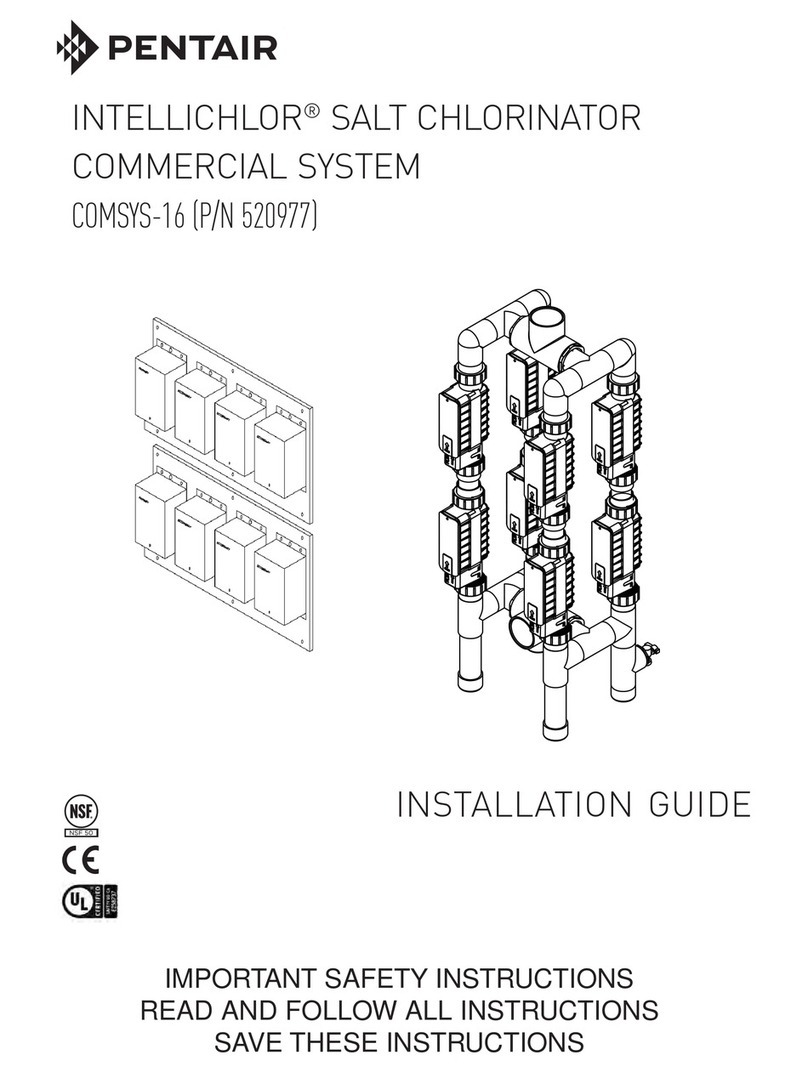
Pentair
Pentair INTELLICHLOR COMSYS-16 installation guide

Hellenbrand
Hellenbrand H200M HE-16 owner's manual

Hellenbrand
Hellenbrand Water Conditioning System H-125 Series Specification sheet
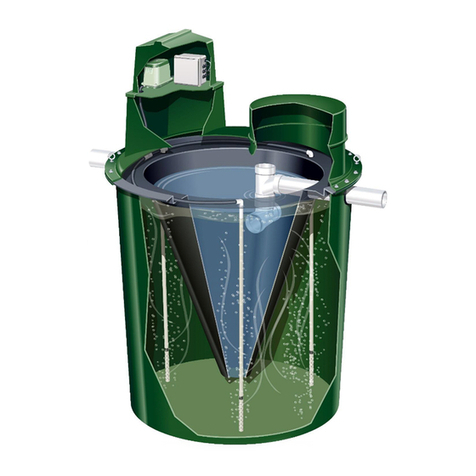
Hydro Action
Hydro Action AP-500 Operation & maintenance manual
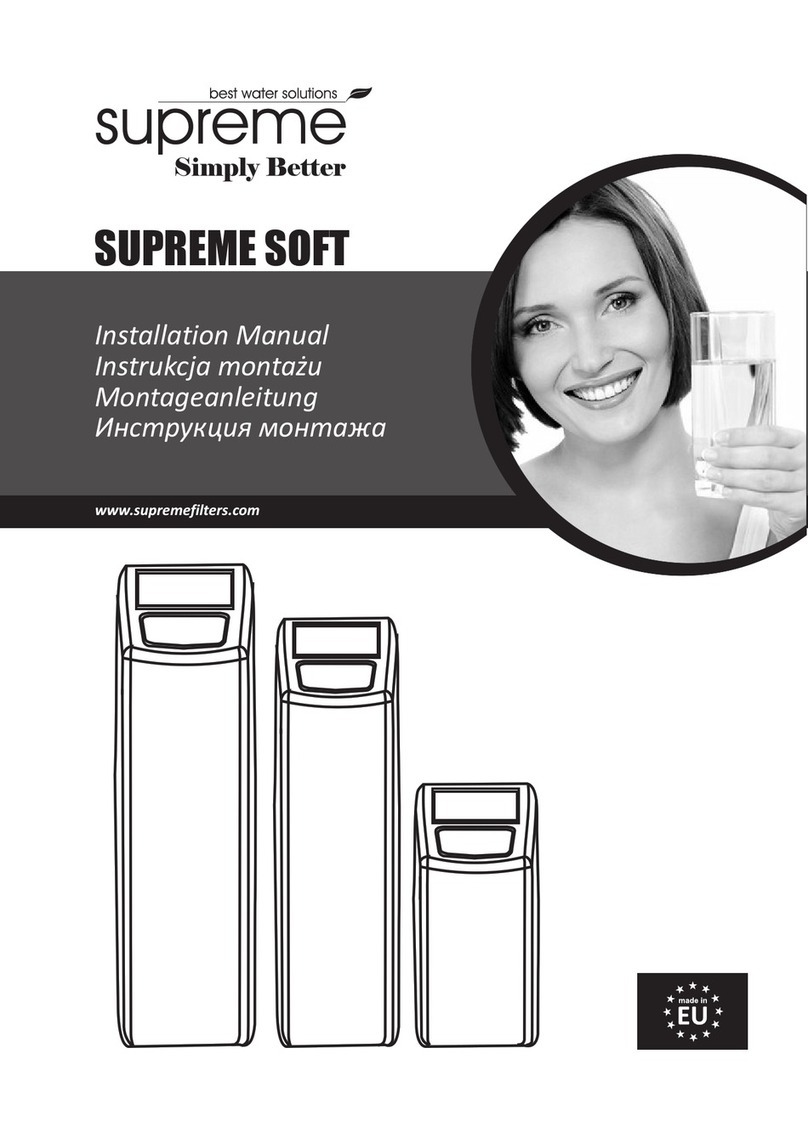
SUPREME
SUPREME SOFT installation manual
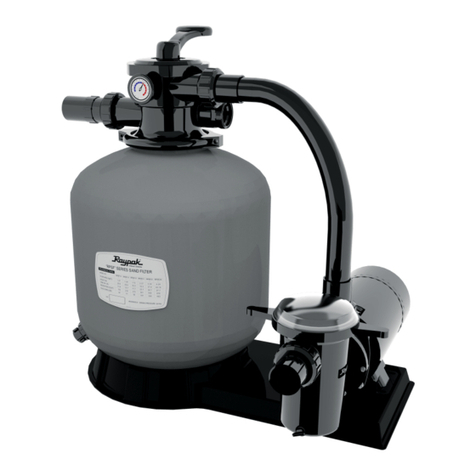
Raypak
Raypak RPSFP16 Installation and operation manual
